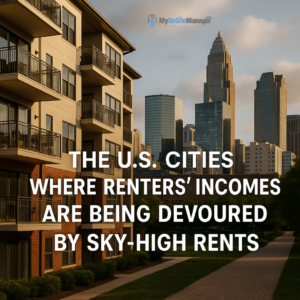In today’s rental landscape, the term “rent burden” is becoming more than just a buzzword—it’s a daily reality for millions of Americans. A recent report by 24/7 Wall St. sheds light on just how severe this issue has become by identifying the most rent-burdened cities in every U.S. state. The findings are sobering: in many cities, renters are handing over more than 30% of their income just to keep a roof over their heads.
What Does “Rent-Burdened” Really Mean?
According to the U.S. Department of Housing and Urban Development (HUD), housing is considered affordable when a household spends no more than 30% of its gross income on housing costs. Once that threshold is crossed, families may start struggling to pay for other essentials—like food, transportation, healthcare, or childcare.
But in the cities spotlighted in this report, that threshold isn’t just crossed—it’s obliterated.
A Look at the Data
Using recent data from the 2023 American Community Survey, the report highlights the most unaffordable city in each state with populations of at least 50,000. Here are some alarming takeaways:
-
Eight cities in the U.S. now have rent-to-income ratios over 30%, officially classifying the average renter as rent-burdened.
-
The national median rent-to-income ratio is 20.6%, but many highlighted cities push far past that.
-
Even in more affordable states, the “most expensive city” still has rent levels that strain local incomes.
These stats underline a troubling reality: even median income earners in these cities are feeling the pinch, and the affordability gap is widening.
Cities Where Rent Is Swallowing Paychecks
Some notable cities that topped the list for their respective states include:
-
Santa Fe, New Mexico
Renters here spend nearly 35% of their income on housing, making it one of the most burdened cities nationwide. -
Birmingham, Alabama
Although not traditionally known for high housing costs, rents are taking a bigger bite out of paychecks than ever before. -
Bend, Oregon
A once-small town that’s become a destination for remote workers—now facing big-city rent prices.
And while these cities vary in size, region, and local economies, they all have one thing in common: rents are growing faster than incomes.
Why Is This Happening?
There are several overlapping factors contributing to this housing affordability crunch:
-
Stagnant Wages vs. Rising Rents
While rent prices continue to climb, wage growth has failed to keep pace in many regions—particularly for renters in service and gig-economy jobs. -
Low Housing Supply
In many cities, new housing construction hasn’t kept up with demand. This supply-and-demand imbalance drives prices upward, especially in areas with population growth or limited land. -
Zoning and Regulatory Barriers
Restrictive zoning laws make it difficult to build multifamily or affordable housing in many communities—especially in suburban areas resistant to change. -
Inflation and Cost-of-Living Increases
As the cost of goods, services, and utilities rises, renters are squeezed even further—pushing housing affordability out of reach.
Why It Matters
When a growing number of residents spend more than 30%—and in some cases over 50%—of their income on rent, the effects ripple throughout their lives and the local economy:
-
Financial insecurity increases, making it harder to save, invest, or plan for the future.
-
Mobility becomes limited, as people are priced out of neighborhoods or forced to relocate to less desirable areas with fewer opportunities.
-
Local businesses struggle to retain workers who can’t afford to live near their jobs.
-
Public services are stretched, as more residents require assistance or face homelessness.
The affordability crisis doesn’t just impact low-income earners—it’s creeping up the middle-class ladder.
What Can Be Done?
There’s no single fix to the housing affordability crisis, but here are a few strategies that experts and policymakers are considering:
-
Expand affordable housing through federal and local subsidies, tax incentives, and fast-tracked approvals for developers.
-
Reform zoning laws to allow for more high-density housing, accessory dwelling units (ADUs), and mixed-use developments.
-
Invest in rent control and tenant protections, where appropriate, to help stabilize communities and prevent displacement.
-
Boost wage growth and provide housing assistance to those most affected by high rent burdens.
Without bold and coordinated action, housing affordability will continue to erode—leaving more renters behind.
Source: These Unaffordable Cities Are Gobbling Up Renters’ Income Like No Other
https://247wallst.com/housing/2025/04/13/these-unaffordable-cities-are-gobbling-up-renters-income-like-no-other/

